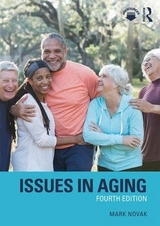
Issues in Aging
Routledge (Verlag)
978-0-205-83195-1 (ISBN)
- Titel erscheint in neuer Auflage
- Artikel merken
Issues in Aging, 3rd edition takes an optimistic view of aging and human potential in later life.
This book presents the most up-to-date facts on aging today, the issues raised by these facts, and the societal and individual responses that will create a successful old age for us all.
Mark Novak presents the full picture of aging- exhibiting both the problems and the opportunities that accompany older age. The text illustrates how generations are dependent on one another and how social conditions affect both the individual and social institutions.
Learning Goals
Upon completing this book, readers will be able to:
Understand how large-scale social issues — social attitudes, the study of aging, and demographic issues affect individuals and social institutions
Identify the political responses to aging and how individuals can create a better old age for themselves and the people they know
Separate the myths from the realities of aging
Recognize the human side of aging
Trace the transformation of pension plans, health, and opportunities for personal expression and social engagement to the new ecology of aging today
Note: MySearchLab does not come automatically packaged with this text. To purchase MySearchLab, please visit: www.mysearchlab.com or you can purchase a ValuePack of the text + MySearchLab with Pearson eText (at no additional cost). ValuePack ISBN-10: 020586368X / ValuePack ISBN-13: 9780205863686
Mark Novak is Dean and Associate Vice President of the Department of International and Extended Studies at San Jose State University. He has a taught a course in Aging and Society for over 20 years.
IN THIS SECTION:
1.) BRIEF TABLE OF CONTENTS
2.) FULL TABLE OF CONTENTS
BRIEF TABLE OF CONTENTS:
Chapter 1: Aging Today
Chapter 2: Theories and Methods
Chapter 3: Demography
Chapter 4: Personal Health and Well-Being
Chapter 5: The Life Course
Chapter 6: Race and Ethnicity
Chapter 7: Retirement and Work
Chapter 8: Housing and Transportation
Chapter 9: Leisure, Recreation, and Education
Chapter 10: Family Life and Social Support
Chapter 11: Social Support
Chapter 12: Death and Dying
FULL TABLE OF CONTENTS:
Chapter 1: Aging Today
Why Study Aging?
Ageism
Culture as A Source of Ageism
The Media as a Source of Ageism
Lack of Knowledge as a Source of Ageism
Some Facts on Aging Today
Victimization by Fraud
Effects of Victimization
Fear of Crime
The Ageless Self: Another Form of Ageism
Responses to Ageism
Change on the Horizon
The Media
The Senior Market: A New Image of Aging
Education Programs
Intergenerational Programs
Legislation and Social Action
Conclusion
Summary
Discussion Questions
Suggested Reading
Websites to Consult
Chapter 2: Theories and Methods
The Study of Aging: Past and Present
Early Developments in Research
Gerontology Research Today
Is Gerontology A Discipline?
Theories of Aging
Two Levels of Theories
Three Theoretical Perspectives
Interpretive Perspective
Critique of the Interpretive Perspective
Functionalist Perspective
Age Stratification Theory: An Example of the Functionalist Perspective
Individual Aging
Societal Change
Critique of the Functionalist Perspective
Conflict Perspective
Critique of the Conflict Perspective
New Developments in Theory
Experimental Designs
Cross-Sectional Designs
Longitudinal Designs
Quantitative and Qualitative Methods
The Humanities
Information Literacy: The Challenge of the Internet
Ethical Issues in Research
The Future of Gerontological Theory and Methods
Conclusion
Summary
Discussion Questions
Suggested Reading
Websites to Consult
Chapter 3: Demography
The Challenge of Population Aging
What Is Population Aging
The Demographic Transition
Three Types of Societies and Population Aging
The Less Developed Nations
China: A Case study of Population Aging in a Developing Nation
The Least Developed Nations
Ghana: A Case Study of Population Aging in a Least Developed Nation
Summary of Aging in Developing and Least Developed Nations
The developed nations
Japan: A Case Study of Population Aging in a Developed Nation
Population Aging in the United States
Increased Numbers of Older People
Increased Proportion of Older People
The Causes of Population change
Migration
Death Rates
Birth Rates
The Challenges of an Aging Population
The Aging of the Older Population
Ethnic and Racial Variations
Regional Distribution
Accumulation
Recomposition
Congregation
Interstate Migration
Amenity Migration
Retirement
Moderate Disability
Major Chronic Disability
Urban–Rural Distribution
Changes in the Sex Ratio
The Impact of Population Aging
Support (or Dependency Ratios)
Critique of Dependency Ratios
Conclusion
Summary
Discussion Questions
Suggested Reading
Websites to Consult
Chapter 4: Personal Health and Well-Being
Biological Aging
Theories of Biological Aging
Programmed Theories
Programmed Senescence
Endocrine and Immunological Theory
Error Theories
Somatic Mutation Theory
Cross-Linking Theory
Free Radicals Theory
Other Theories
The Effects of Aging on Body Systems
Musculoskeletal System
Sensory Changes
Taste, Smell, and Touch
Sight
Hearing
Personal Health and Illness
Changes in Health Status
Limits on Activity Due to Physical Decline
Coping with Physical Change
Improvements in Technology
Improvements in the Environment
Improvements in Self-Care
Improvements in Lifestyle
Compression of Morbidity Hypothesis
Successful Aging
Rowe and Kahn’s Model of Successful Aging
The SOC Model of Successful Aging
A Life Course Model of Successful Aging
Anti-Aging Medicine and Science
Social Inequality and Personal Health
Conclusion
Summary
Discussion Questions
Suggested Reading
Websites to Consult
Chapter 5: The Life course
Memory and Intelligence
Experience and Mental Function in Later Life: The Study of Reading
Summary of Memory Research
Intelligence
New Models of Mental Ability in Later Life
The Study of Wisdom in Later Life
Creativity
Personality Development and the Self
Self-Development in Later Life
Spirituality: The Search for Meaning in Later Life
Social Psychological Change
Disengagement Theory
Activity Theory
Continuity Theory
The Life Course Perspective
The Structure of the Life Course
Life Events
Psychological disorders: abnormal aging
Organic Disorders: Cognitive Impairment in Later Life
Functional Disorders
Loneliness
Social Breakdown and Reconstruction
Conclusion
Summary
Discussion Questions
Suggested Reading
Websites to Consult
Chapter 6: Race and Ethnicity
Who Are the Minority Elderly?
Why Study Minority Aging?
Demographic Characteristics of Dominant and Minority Group Elders
Whites: The Dominant Group Older Population
The Minority Older Population
Diversity of the Minority Population
Aging of the Minority Population
Three Theories on Minority Group Aging
Multiple Jeopardy
Critique of Multiple Jeopardy Theory
Leveling
The Life Course Perspective
Institutional Completeness: An Example of Life Course Differences
Structured Inequality and Personal History
The Impact of Minority Group Membership on Aging
A Look at Four Minority Groups
African Americans
Hispanic Americans
Asian Americans
American Indians and Alaskan Natives (AIAN)
Responses to Minority Group Aging
Future Issues
Conclusion
Summary
Discussion Questions
Suggested Reading
Websites to Consult
Chapter 7: Retirement and Work
The Social Origins of Retirement
Retirement in the United States Today
Women and Retirement
Minorities and Retirement
Alternatives to Retirement
Early Retirement
Partial Retirement
Second Careers
Personal Responses to Retirement
Social Structures and Retirement
The Dual Economy
Displaced Workers
The Future of Retirement
Conclusion
Summary
Discussion Questions
Suggested Reading
Websites to Consult
Chapter 8: Housing and Transportation
Living Arrangements
An Ecological Model of Housing
Housing Options
Single-Family Homes
Apartment Living
Congregate Housing and Assisted (Apartment) Living
Subsidized Housing
Single Room Occupancy (SRO)
Supportive Housing
Accessory Dwelling Units
Home Sharing
Retirement Communities
Continuing Care Retirement Communities
Low-Income, Rural, and Minority Housing
Homelessness
The Future of Housing
Transportation
Public Transportation
Private Transportation
Conclusion
Summary
Discussion Questions
Suggested Reading
Websites to Consult
Chapter 9: Leisure, Recreation, and Education
Leisure
Age and Leisure
Gender and Leisure
Minority Status and Leisure
Leisure Education
New Activities in Old Age
Outdoor Recreation
Fitness, Health, and Well-Being
Senior Centers
Education
Formal Higher Education
Informal Educational Options
Elderhostel
Lifelong Learning Institutes
The Future of Education for Older People
Community Service and Volunteer Work
Volunteer Opportunities
Conclusion
Summary
Discussion Questions
Suggested Reading
Websites to Consult
Chapter 10: Family Life and Social Support
Marriage and Widowhood
Marital Status
Widowhood
Sexuality
Grandparenting
The Future of the Family
Conclusion
Summary
Discussion Questions
Suggested Reading
Websites to Consult
Chapter 11: Social Support
What is Informal Social Support?
Family Life and Family Supports
Informal Supports for Older People
The Role of Formal Supports
Supports for Childless Older People
Minority Differences in Social Support
Websites to Consult
Caregiving
Gender Roles and the Challenge of Caregiving
The Future of Informal Support
Eldercare and the Workplace
Older People as Family Supporters
Elder Abuse
The Future of Social Supports
Summary
Discussion Questions
Suggested Reading
Websites to Consult
Chapter 12: Death and Dying
Death and Society
Death in Old Age
The Experience of Dying
Institutional Death
Changes in the Treatment of the Dying
Stages of Death and Dying
Hospice Care
Palliative Care
Ethical Issues
Advance Directives
Euthanasia and Physician-Assisted Suicide
Mourning and Grief
Conclusion
Summary
Discussion Questions
Suggested Reading
Websites to Consult
Works Consulted
Glossary of Terms
Index
| Erscheint lt. Verlag | 6.12.2011 |
|---|---|
| Verlagsort | New York |
| Sprache | englisch |
| Maße | 204 x 255 mm |
| Gewicht | 900 g |
| Themenwelt | Sozialwissenschaften ► Soziologie |
| ISBN-10 | 0-205-83195-8 / 0205831958 |
| ISBN-13 | 978-0-205-83195-1 / 9780205831951 |
| Zustand | Neuware |
| Informationen gemäß Produktsicherheitsverordnung (GPSR) | |
| Haben Sie eine Frage zum Produkt? |
aus dem Bereich



